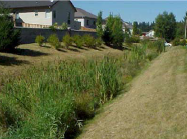
Vegetated Swales/Dry Swales
Stormwater
Source Water Protection
Swales are drainage paths or vegetated channels used to transport water. They can be used in small drainage areas with low runoff instead of underground storm sewers or concrete open channels. Swales help slow runoff, facilitate infiltration and filter pollutants as runoff flows through the system. Swales that are slopes are called contour swales.
Monitor sediment accumulation and remove as necessary; Inspect channel and repair any eroding surfaces or damaged vegetation; Ensure vegetation is well established; Remove debris from any inlet and outlet structures. Once established, vegetated swales have minimal maintenance needs outside of the spring cleanup, regular mowing, repair of check dams and other measures to maintain the hydraulic efficiency of the channel and a dense, healthy grass cover. Maintenance requirements for vegetated swales include the following: 1. Maintain grass height of 3 to 4 inches. 2. Remove sediment build up in channel bottom when it accumulates to 25% of original total channel volume. 3. Ensure that rills and gullies have not formed on side slopes. Correct if necessary. 4. Remove trash and debris build up. 5. Replant areas where vegetation has not been successfully established.
Individual swales should be designed to treat relatively small, flat drainage areas. If swales use slopes steeper than four percent, or if they treat areas larger than 5 acres, the flow velocity may be too great for effective treatment and erosion could occur. Unless existing soils are highly permeable, they are replaced with a sand/soil mix that meets minimum permeability requirements. An underdrain system may also be installed under the soil bed. Typically, the underdrain system is created by a gravel layer which encases a perforated pipe. The bottom of the swale should be at least three feet above groundwater in order to prevent the swale bottom from remaining too wet. The swale should have trapezoidal or parabolic cross section with relatively flat side slopes (less than 3:1). The flat channel bottom should be between two and eight feet wide to ensure sufficient filtering surface for water quality treatment. Contributing drainage area ≤ 5 acres: Longitudinal slope ≤ 4%; Side slopes 3:1 (H:V) or flatter; Bottom width of channel should be between 4 and 8 ft wide; Flow velocities in channel must be: less than 1 fps during a 1” storm event, and; non-erosive during the 2-year and 10-year design storm events. 10-year design flow must be contained within the channel which must have a 6” minimum freeboard. Dense vegetation capable of withstanding relatively high flow velocities and alternating dry and wet periods. Check dams and compost material can be added to maximize pollutant capture and stormwater infiltration, respectively
Low. Roadside swales in residential settings achieve substantial documented cost savings over conventional curb and gutter and stormwater systems. In a suburban example in Chicago, a savings of about $800 per residence was estimated. Generally, costs may range from less than $0.10 to as much as $0.50 per cubic foot.
Provides effective stormwater flood control by slowing down runoff and storing water, including water infiltration into the soil; Improves water quality by filtering pollutants from stormwater (oils, greases, metals, and sediments that can be picked up from paved surfaces; Can be used as a system by itself or in conjunction with other Best Management Practices; Easy to plan and build; Reduces erosion; Flexible to incorporate existing natural features Preserves natural/native vegetation and provides habitat for wildlife. Protects adjacent properties. Although periodic cleaning may be required, swales should never need to be replaced, in contrast to conventional stormwater systems Provides pretreatment when used as part of runoff conveyance system. Provides partial infiltration of runoff in pervious soils. Less expensive than typical curb and gutter. Wildlife habitat potential. Reduces thermal effects of impervious surfaces
Tennessee Permanent Stormwater Management and Design Guidance Manual - 5.4.3 Vegetated Swale
Alternative Stormwater Best Management Practices Guidelines
Stormwater Management the Natural Way
Pennsylvania Stormwater Best Management Practices Manual BMP 6.4.8: Vegetated Swale